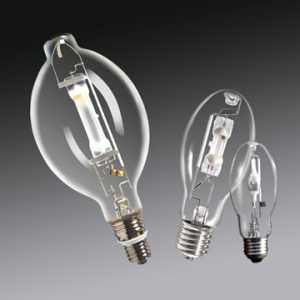Metal Halide lighting systems are very popular in commercial buildings and retail stores as area lighting, and shopping centers, commonly as the most common form of parking lot lighting in today’s market. Yet anyone who has the responsibility of maintaining these lighting systems, knows that sometimes metal halide can be very expensive. Not only from electrical consumption, but the cost of light bulbs, ballasts, labor and often times lift fees can be very tolling to a businesses bottom line.
The number one reason Metal Halide or HID lighting can be costly is the lack of preventative maintenance.
 Like any light bulb, Metal Halide lamps offer significant signs that it is time to replace a light bulb. Unfortunately, most people do not take the time to notice the warning signs. First we must understand, that the only light bulbs that can be run to their hard fail point is incandescent and halogen light bulbs. These lamps have only a filament that breaks, thus breaking the circuit upon failure. But all other commercial lamps such as CFL, Fluorescent, and HID require ballasts. Any light bulbs or lighting system requiring ballasts, is NOT designed to run until a lamp burns out completely. Failure to replace a commercial light bulb before complete lamp failure will damage the ballast and cause a drastic increase in maintenance costs.
Like any light bulb, Metal Halide lamps offer significant signs that it is time to replace a light bulb. Unfortunately, most people do not take the time to notice the warning signs. First we must understand, that the only light bulbs that can be run to their hard fail point is incandescent and halogen light bulbs. These lamps have only a filament that breaks, thus breaking the circuit upon failure. But all other commercial lamps such as CFL, Fluorescent, and HID require ballasts. Any light bulbs or lighting system requiring ballasts, is NOT designed to run until a lamp burns out completely. Failure to replace a commercial light bulb before complete lamp failure will damage the ballast and cause a drastic increase in maintenance costs.
In the case of Metal Halide, most manufacturers rate these HID light bulbs with a life of approximately 20,000 hours. This rating traditionally means the point in which 50% of the lamps will fail, but in the case of maintenance, this is the DO NOT EXCEED time of all lamps. At this point, all lamps should be replaced.
Replacing lamps before they burn out, saves money!
Signs that a Metal Halide light bulb or ballast needs replaced:
- The lamp appears to be a different color, or are turning pink
 This is known as color shift, a natural effect of Metal Halide over long periods of operation. Usually the lamps will gain a pinkish hue when compared to other lamps in the same system. This is caused when metal vapors in the lamp are expired from heat or burning, and the lack of a particular mixture in the arc tube renders a different color. By this point, most lamps have lost at least 40% of their original light output. The lamp needs to be replaced as continued operation will damage the ballast.
This is known as color shift, a natural effect of Metal Halide over long periods of operation. Usually the lamps will gain a pinkish hue when compared to other lamps in the same system. This is caused when metal vapors in the lamp are expired from heat or burning, and the lack of a particular mixture in the arc tube renders a different color. By this point, most lamps have lost at least 40% of their original light output. The lamp needs to be replaced as continued operation will damage the ballast.![]()
- The lamp is cycling on an off, or takes a long time to come on
This is often misdiagnosed by electricians who do not have expert knowledge of HID lighting systems. The most common correction most find for this is to replace the light bulb. Once a new lamp is installed, the metal halide bulb will light and come up to full brightness. However, this is not the correct repair. The ballast in an HID lighting system requires a capacitor, this is a current limiting device that prevents too much amperage to be delivered to the HID bulb. As a metal halide lamp ages, it will require a greater load to maintain illumination. Because of the extreme heat produced by the HID system, the liquid gel that fills the capacitor will crystallize and change the electrical characteristics of the capacitor. At this point the capacitor is providing a low power factor and delivering a higher current than designed. The metal halide lamp will receive an unrestricted current (amp draw) and become brighter until it cuts out again. Then the thermal switch will cool, reset and the cycle repeats. This will prematurely fail the new replacement lamp and result in heavy blackening of the arc tube. The ballast, capacitor and lamp need to be changed.![]()
- The fixture makes a humming noise
When a metal halide lamp receives a higher amp load than it was designed for due to the capacitor characteristics changing, the operating temperature of the ballast will rise tremendously. When the ballast overheats, the varnish coating of the coil will begin to melt away from the copper winding of the coil. This coating is what prevents the windings from vibrating against each other. At the point in which the ballast is buzzing, the windings are now beginning to touch, and vibrate resulting in sound. Eventually the varnish will melt enough to allow winding to short across each other, thus resulting in complete failure of the ballasts, and usually will trip a circuit breaker, downing the entire circuit.![]()
- The light bulbs appears to turn green or blue
Mostly we find that the lamps turn a greenish color, either light to heavy green. This is caused by a capacitor becoming weak with age. It is delivering a high power factor, enough to maintain illumination of the lamp, but a low current, not enough to illuminate the lamp completely. The gases in the arc tube are not reaching their peak operating temperature, and the lamp glows green. Sometimes the capacitor itself can be replaced and the system will recover. However if the fixture is part of a parking lot lighting system, this is a good sign that the components are very old, and the ballast itself may not last long, as it will be the weak link of the system. It is a good idea to change the ballast and capacitor at this point. A return trip with labor and lift in as short as a month would cost more than the ballast at the time.![]()
- A new Metal Halide bulb isn’t as bright or white as the old bulbs
This is a common compliant for businesses replacing a small portion of metal halide lamps, and mostly is the complaint we receive when the customer or electrician replaced a burnt out lamp. Manufacturers make most metal halide lamps in two color temperatures, 3000K which appears slightly yellowish, and 4000k which appears brighter white. Sometimes this can be caused by using different color lamps, or one brand to another may have varying degrees of color. Acceptable limits of color are 300 degrees of variance. However, if the lamps have been burning for a long period of time, you may never match the existing lamp.
As the metal halide lamp becomes older, it will require a higher load (amp load), and when burning on the same capacitor, the system in whole is becoming out of spec by the bulb and capacitor both requiring and delivering this higher amp load simultaniously. When the metal halide lamp requires and is delivered the higher amp load, the color of the lamp will become whiter and seemingly brighter. ![]()
![]()
When installing the new lamp with the right color temperature on a system with this age, the new lamp does not require as high of a current as the old lamps, and it will never appear to have the same level of “whiteness” as the old lamps. The only cure is to replace all the lamps in the system. This is a good idea, because again running the old lamps until they fail will damage the ballast. The ballast itself continues to operate even with a bad lamp and will over work itself continually trying to ignite a bad lamp.
![]()
The most affordable way to maintain an HID Lighting System is to divide your operating hours per year into the lamp life and determine the length of time before completely relamping the system will be required. At that time, relamp the system which will prolong ballast and capacitor life, and you will see a significant savings in both ballast costs, and labor repairs.
For more information on HID Lighting Systems, view our website or call Synergy Lighting for a free consultation.
Phone: (941)-756-4844
Toll Free: (877) 220-5483
e-mail: sales@synergylightingusa.com


[…] Most often we find that retailers do not put a focus on parking lot lighting fixtures due to high costs of repair and energy consumption. There are many alternatives such as LED and Induction lighting that can […]
[…] Color shift, lights turning green and pink […]
[…] extremely high. The metal halide lighting systems suffer from a wide variety of problems from color shift (lamps turning pink and green) and if not replaced regularly well before the useful life is reached […]